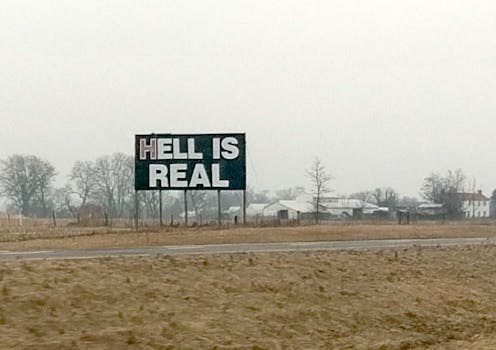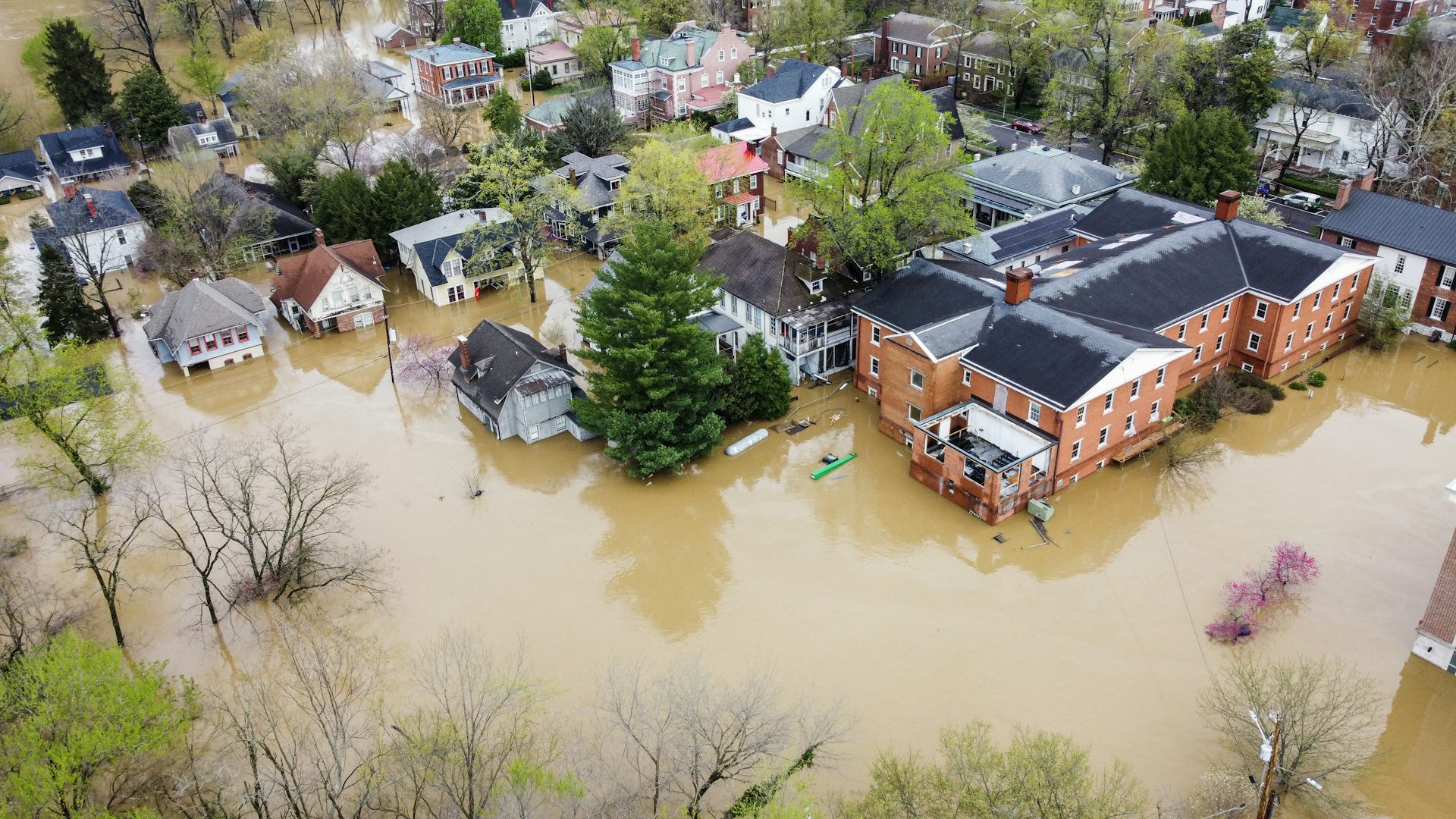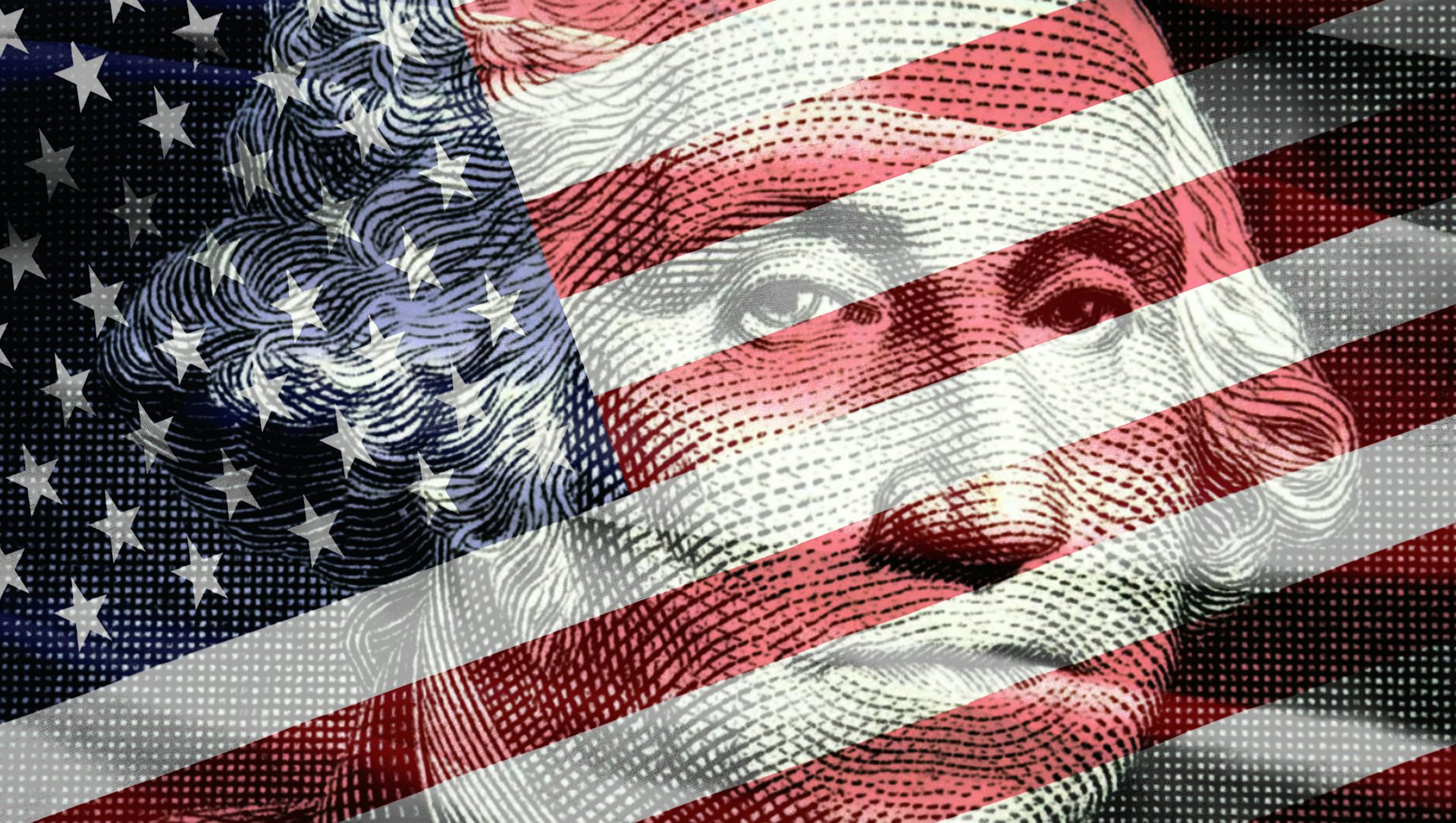How 19th-century Spiritualists ‘canceled’ the idea of hell to address social and political concerns
Spiritualists believed that after shedding the body in death, the spirit would continue on a celestial journey and help those on Earth create a more just world.

Between Columbus and Cincinnati, Ohio, drivers pass a billboard on Interstate 71 that has achieved some internet fame.
Since 2004, a black sign has risen from this flat stretch of highway declaring “HELL IS REAL.” The H in “Hell” is painted in red, a color Christians have long associated with sin and Satan.
The developer who erected the warning, Jimmy Harston, has similar signs scattered across the Midwest, including ones that ask, “If you died today, where would you spend eternity?”
For years, this confrontational sign was mostly a local attraction. But it gained wider notoriety when Ohio’s two Major League Soccer teams, Columbus Crew and FC Cincinnati, dubbed their 2017 matchup “Hell is Real.” The sign has now spawned TikTok content, T-shirt designs, mugs and decals. But it also reflects a genuine belief in hell held by a majority of Americans today, though the numbers are slipping.
A 2023 Gallup poll found that 59% of respondents believe in hell, while 67% believe in heaven. The numbers for hell belief are far higher among those who identify as Protestant Christians (81%) and Republicans (79%).
Hell belief is holding steady in the U.S., but this was not always the case. In my research on spirit communication in 19th century American culture, I have found an organized effort to “cancel” hell by Spiritualists, who made up the fastest-growing religious movement of the century.
Spiritualists believed that people could maintain communication with the living even after death. They thought communicative spirits had a principal role to play in addressing the era’s most pressing social and political concerns, which would be impossible if souls were damned. This idea was a cornerstone of their practice and a driver of their politics.
Hell hath no fury
Many traditions, including Catholic Christianity, have beliefs about eternal destiny, but Protestant beliefs predominated in America’s settler colonies.
Puritan minister Michael Wigglesworth’s epic and best-selling poem “Day of Doom,” written in 1666, scared generations of believers with its vivid depiction of “yonder Lake,/where Fire and Brimstone flameth.”
A century later, revivalist minister Jonathan Edwards warned of the “dreadful pit of the glowing flames of the wrath of God” awaiting the unrepentant.
On the edges of organized religion, though, were believers interested in alternative afterlives. Swedish theologian and scientist Emmanuel Swedenborg, for example, speculated in 1758 that “The world of spirits is not heaven, nor is it hell; but it is a place or state intermediate between the two.”
Swedenborg’s ideas gained public traction in the U.S. after sisters Kate and Margaret Fox of Hydesville, New York, reported “rapping” and “knocking” sounds in their home. The knocking seemed responsive to the sisters’ questions, and they soon claimed that they could hold conversations with the deceased. Rising from this domestic drama was a national and international phenomenon that recalibrated people’s relationship with death and offered a balm to the grieving.
Some of the Foxes’ first advocates were Quaker activists Isaac and Amy Post. Isaac Post became a writing medium, recording alleged spirit communications from luminaries like George Washington and Napoleon Bonaparte and also everyday people.

Spiritualists held that after shedding the body in death, the spirit would continue on a celestial journey. A spirit’s assignment was to help those still in their bodies to create a better, more just world. Through mediums, séances and object manipulation, spirits were believed to be able to enlighten the living by giving them a glimpse into life on a broader plane of existence.
Spiritualists felt that embodied life was narrow and full of biases, wants, needs and conflicts. In his 1850 book, “Singular Revelations,” spirit medium Eliab W. Capron recorded an insight he claimed to receive from the spirit of radical Methodist preacher Lorenzo Dow, who had died 14 years prior: “The Presbyterians say hell is a place of fire and brimstone that burns the soul forever. This is not so. The Hell is man’s own body, and when he escapes from that he escapes from bondage.”
Fires of reform
In neutralizing the threat of hell, Spiritualists believed that even deeply corrupted spirits could spur the living toward progressive reforms.
In an 1858 gathering of self-described “friends of free thought” in Vermont known as the Rutland Free Convention, Spiritualists and social reformers debated the question of hell vis-a-vis issues like slavery, the death penalty and maternity.
Lecturer and clairvoyant Andrew Jackson Davis cheekily announced to the Rutland crowd, “Hell has undergone the most extensive alterations and improvements” in the hands of Spiritualists. By caring “less about the fear of the devil, and more about the actual necessity of goodness,” people could act expediently to address real social problems rather than fight what Davis considered imaginary ones.

Spirit medium Ascha Sprague linked hell belief to the persistence of capital punishment in American jurisprudence, asking, “Who blames man that he hangs his brother between heaven and earth, when he has been taught to believe that the Almighty God, infinite in power and wisdom, will in a moment plunge him into a burning pit, and save him never?”
In other words, Spiritualists warned that the idea of hell allowed people to remain complacent: Let hell punish the brutal enslaver, the cruel prison warden, the merciless factory foreman, the abusive husband. Hell gave believers a way to escape the responsibility of addressing burning social ills in the here and now. By relinquishing the “bottomless pit, which they have been taught to believe in,” Isaac Post quoted a spirit saying, a new ethos of urgent and sweeping reform could materialize.
Even today, some spiritual activists consider hell belief an impediment to systemic social change. For example, prison abolitionist Hannah Bowman wrote in a 2023 collection on spirituality and abolition, “Insofar as hell is defined by coercion/confinement, separation, and retribution, it is to some degree related to any societal and state interventions reliant upon those practices.”
To hell and back
Putting out the fires of hell was not easy in the 19th century U.S., especially at the outbreak of the Civil War when mass death fed apocalyptic rhetoric. The promise of God’s “terrible swift sword” of judgment was sung out in the canonical words of suffragist Julia Ward Howe’s “Battle Hymn of the Republic.”
Spiritualism’s popularity waxed and waned after the war, and its reformist leanings largely faded. Mass casualty events like war and flu led to periodic revivals, especially of séance culture. But hell belief in America ultimately held steady and reignited by the middle of 20th century.
The reasons for this range from a decline in religious belief between the world wars to a religious revival following them, and the horrors of war itself. In his 1949 memoir, “To Hell and Back,” World War II 2nd Lt. Audie Murphy recounts a fellow soldier’s impromptu verses; “Oh, gather round me comrades and listen while / I speak / Of a war, a war, a war, where hell is six feet deep.” Hell was everywhere.
Cornell University’s Roper Center poll from 1957 – in the thick of the Cold War – found that 74% of Americans polled believed in an afterlife, but 84% felt that the dead were uncommunicative. These modern trends indicate that hell belief captures the zeitgeist of an era. It ebbs and flows along with attitudes about justice, human suffering and even the health of the planet.
The “Hell is Real” sign has experienced a similar flux. Last summer, street artist LISP pasted a cutout of a cartoonish red devil on the highway sign and shared the covert operation on Instagram. “Is nothing sacred?” one user asked, riffing on the sign’s iconic, if peculiar, status. The sign has since been replaced with a fresh one, a visible reminder that for some people, hell belief will never die.
Lindsay DiCuirci does not work for, consult, own shares in or receive funding from any company or organization that would benefit from this article, and has disclosed no relevant affiliations beyond their academic appointment.
Read These Next
Damn the torpedoes! Trump ditches a crucial climate treaty as he moves to dismantle America’s climat
At the same time, Americans have been facing worsening storms, wildfires and deadly heat waves.
George Washington’s foreign policy was built on respect for other nations and patient consideration
For the nation’s first president, friendliness was strategy, not concession: the republic would treat…
The 6-7 craze offered a brief window into the hidden world of children
From Pig Latin to Punch Buggy, kids have long used nonsensical language, gestures and games to carve…





